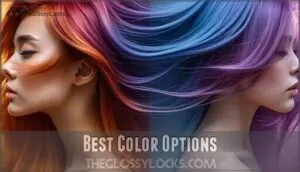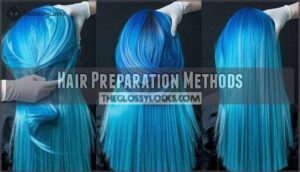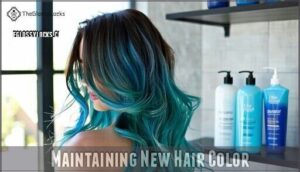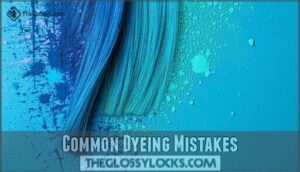This site is supported by our readers. We may earn a commission, at no cost to you, if you purchase through links.
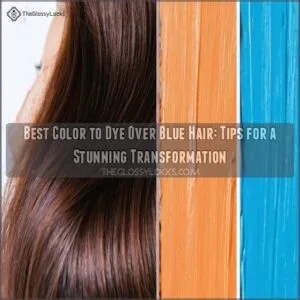
For darker shades, warm neutrals like chocolate brown or auburn work well to cover it up.
If your blue is lighter, vibrant colors such as orange or pink can create striking contrasts, while soft pastels like lavender or peach can blend beautifully.
Neutralizing the blue tones with an orange-toned toner might also help for a more even base.
Preparing your hair with proper conditioning and ensuring it’s healthy before dyeing can make all the difference, and remember the possibilities are endless—choose wisely!
Table Of Contents
- Key Takeaways
- Dyeing Over Blue Hair
- Best Color Options
- Hair Preparation Methods
- Maintaining New Hair Color
- Common Dyeing Mistakes
- Frequently Asked Questions (FAQs)
- What colors can I dye over blue hair?
- What color hair dye cancels out blue?
- What color best covers blue?
- What will remove blue hair dye?
- What hair dye works best on damaged hair?
- Can blue hair be dyed lighter safely?
- Which natural dyes effectively cover blue hair?
- How does scalp health affect dyeing results?
- What temporary options hide grown-out blue roots?
- Conclusion
Key Takeaways
- Neutralize blue tones with an orange-based toner or copper shades for a smoother color transition.
- Warm tones like auburn, chocolate brown, or copper effectively cover darker blue shades.
- Lighter blue hair pairs well with vibrant colors like pink or orange, or soft pastels like lavender.
- Prep your hair with conditioning treatments to ensure even application and minimize damage.
Dyeing Over Blue Hair
When you’re ready to change your blue hair, picking the right color is essential for a smooth transformation.
Start by understanding how to neutralize blue tones and choose shades that complement or enhance your desired look.
Color Correction Techniques
Starting with a pre-color analysis, you can pinpoint the best approach for blue hair color correction.
Follow these steps:
- Remove unwanted pigments using color removers or fade washes.
- Select a toner suited to balance remaining tones.
- Strand test to preview results and minimize surprises.
- Prioritize damage control with treatments to protect hair health before you dye over blue hair.
Neutralizing Blue Tones
Neutralizing blue tones is key before dyeing over blue hair.
Use orange toners, red pigments, or copper shades to counteract blue, as the color wheel suggests.
Properly apply products to avoid uneven results.
A strand test is essential to gauge effectiveness.
To address unwanted tones, consider using toning shampoos effectively.
Here’s a quick guide:
| Tone to Neutralize | Recommended Product | Key Benefit |
|---|---|---|
| Blue | Orange toner | Balances tones |
| Green | Red pigment | Neutralizes green |
| Blue-Green | Copper shades | Softens shade |
Choosing Complementary Colors
Think about the color wheel to choose shades that work with blue tones.
Warmer colors like copper, auburn, or honey balance blue beautifully.
Here’s how to decide:
- Color Wheel Basics: Pick colors opposite blue.
- Skin Tone Harmony: Match shades to your undertone for a unified look.
- Personal Style: Choose hues reflecting your individuality.
Best Color Options
When you’re choosing the best color to dye over blue hair, it’s important to keep in mind shades that complement or neutralize the existing tone.
Options like warm neutral hues, cool pastels, or vibrant contrasting colors can help you achieve a smooth and stunning transformation.
Warm Neutral Shades
Choosing warm neutral shades like rich beige, honey blonde, or caramel is a smart way to cover blue hair.
These tones balance warmth levels and offer versatility.
Apply with precision using proper hair color correction techniques to guarantee even results.
Focus on neutral undertones during application, then maintain warmth with color-safe products.
Hair color theory guarantees seamless coverage and is based on applying with precision and using color-safe products to ensure the desired outcome.
Cool Pastel Colors
Cool pastel colors work beautifully to dye over blue hair, blending soft tones with ease.
Pastel Color Theory shows how lighter shades pair well with existing blue. For those with cool undertones, consider sapphire blue options for a striking look.
Try these trendy looks:
- Lavender for a dreamy vibe.
- Cotton candy pink as a subtle contrast.
- Mint green for freshness.
- Baby blue to enhance depth.
- Pastel turquoise for boldness.
Vibrant Contrasting Hues
If you’re looking for bold and vibrant hair colors, use the color wheel for hair to find complementary combinations that beautifully cover blue.
Warm shades like copper, orange, or rich auburn offer bold undertones and vivid accents.
Contrasting placement, such as highlights or ombre, adds depth. The best dye for stubborn color balances striking hues with seamless blending for stunning results.
Hair Preparation Methods
Before you change the color of your blue hair, it’s important to prepare your strands properly to avoid damage and uneven results.
By focusing on techniques like bleaching, toning, depositing color, and conditioning, you’ll set the foundation for a smooth and stunning transformation.
Bleach and Tone Techniques
Bleaching is essential for lifting blue tones, especially when targeting a lighter hair color.
Start with controlled bleach levels to minimize damage.
Toning formulas refine results, preventing uneven shades.
Focus on even application, from roots to ends, while applying root shadow for depth.
Many stylists buy bleach and toner from online suppliers.
Always prioritize damage control during hair lightening to maintain health and readiness for the next color transformation, ensuring hair health.
Color Depositing Treatments
Boost pigment intensity with color depositing treatments for vibrant results.
These enhance shade longevity while letting you refresh hair color at home.
DIY options like treatment masks deposit new pigment between applications, reducing the need for frequent hair dye sessions.
To further extend color life, consider limiting sun exposure.
For the best color to cover blue, pick warm or neutral tones that balance bold blue hues effectively, and use color depositing treatments to achieve vibrant results.
Hair Conditioning and Repair
Healthy hair is the foundation of any color transformation.
Start with conditioning treatments to restore moisture retention and boost scalp health. Protein treatments strengthen weakened strands, while split end repair prevents further damage.
Regularly addressing hair damage guarantees smoother application and longer-lasting results. For deep nourishment, explore various hair repair options.
Focus on hair health before trying color correction techniques to avoid unnecessary stress on your locks, ensuring a strong base for color transformation and promoting overall hair care.
Maintaining New Hair Color
Keeping your new hair color vibrant requires using sulfate-free, color-safe shampoos and regular conditioning treatments.
Protect your hair from fading by limiting sun exposure, avoiding chlorine, and scheduling touch-ups as needed to maintain color-safe results.
Color Safe Hair Care
Switching to sulfate-free shampoos keeps your color vibrant, while conditioners packed with hydration importance prevent dryness.
UV protection shields hair from fading in sunlight, so opt for color-safe brands offering this. Steer clear of chlorine—it can mess with color maintenance.
Using a color-safe shampoo is essential for maintaining your hair color.
Weekly conditioning treatments help preserve your shade’s intensity, making hair care simple and effective for long-lasting vibrancy.
Regular Touch Ups and Trims
Root touch-ups and trims play a big role in keeping your hair color looking fresh.
Regular trims prevent split ends and support healthy strands, while touch-ups handle your growing hair roots.
Aim for trims every 6-8 weeks and schedule hair color touchups as needed to fight fading factors.
These steps are key for ongoing hairstyle maintenance and color revitalization.
Protecting Hair From Fading
Protecting your color takes effort, but it’s worth it. Use sulfate-free shampoos to prevent hair dye fading. Incorporate UV protection to shield against sunlight.
Don’t forget these essentials:
- Conditioning treatments to keep hair strong and hydrated.
- Toning products to maintain vibrant hues.
- Avoiding chlorine to prevent discoloration.
With proper hair dye aftercare, your color will stay bold and beautiful longer.
Common Dyeing Mistakes
Mistakes during hair dyeing can lead to uneven color or unwanted tones that are hard to fix.
Knowing how to avoid common errors, like improper preparation or choosing incompatible colors, is key to achieving your desired look.
Overlapping Color Applications
Applying hair dye over existing color without proper technique can lead to patchy application and uneven saturation.
Color build-up from previous dye jobs often causes muddy tones and color bleeding.
Avoid overlapping layers of hair dye by using precise sectioning. Stick to professional hair color correction techniques for smooth results and steer clear of repeated touch-ups without proper hair dye removal first.
Using a deep shade of purple can counteract green tones to achieve a better color result, which is a key point for hair dye removal and color correction.
Insufficient Hair Preparation
Skipping preparation leads to blue hair problems like uneven bleaching or patchy application.
Hair porosity, product buildup, and scalp health must be addressed first.
Follow these steps:
- Strip old dye to avoid layering issues.
- Clarify hair to remove product buildup.
- Check porosity for even absorption.
- Treat dryness with a hydrating mask.
- Always patch-test color removal products.
Incompatible Color Combinations
Mixing the wrong shades over blue hair can lead to muddy results or unpredictable outcomes.
Complementary colors, like orange, cause color wheel clashes.
To avoid disasters, follow the hair color science: neutralize blue tones with warm shades that counter green undertones.
Consider proper hair color removal first to tackle hair color challenges and prevent unnecessary fading.
Frequently Asked Questions (FAQs)
What colors can I dye over blue hair?
You can dye over blue hair with shades like purple, teal, or green for seamless blending.
For warmer tones like orange or red, use a color remover or toner first to neutralize the blue.
What color hair dye cancels out blue?
To cancel out blue hair dye, use an orange or copper-based toner.
These warm tones neutralize blue, following the color wheel principle.
Test a strand first to verify the result matches your goal.
What color best covers blue?
You might think blue is tricky to cover, but warm tones like copper, orange, or auburn work wonders.
They neutralize blue’s cool undertones, creating a rich, balanced shade that hides the blue beautifully.
What will remove blue hair dye?
To remove blue hair dye, try a clarifying shampoo or a color remover like Crazy Color Back to Base.
For stubborn shades, a bleach bath or orange-based toner can help neutralize remaining pigments.
What hair dye works best on damaged hair?
Look for semi-permanent dyes with conditioning formulas, like Arctic Fox or Overtone.
These nourish while coloring, making them gentler on damaged hair.
Stick to darker shades—they’re less harsh and provide better coverage on fragile strands.
Can blue hair be dyed lighter safely?
Surprisingly, lightening blue hair safely takes patience.
You’ll need to fade the blue first with clarifying shampoos or color removers.
Then, a professional can gradually bleach and tone it, minimizing damage while achieving lighter shades.
Which natural dyes effectively cover blue hair?
To cover blue hair naturally, try henna for reddish tones or indigo for darker shades.
Both work best on lighter blue hues.
Always strand test first to guarantee even coverage and desired results.
How does scalp health affect dyeing results?
Healthy scalps are the foundation for vibrant dye results.
If your scalp is irritated or dry, it can affect color absorption and evenness.
Keep it clean, moisturized, and free of buildup for the best outcome.
What temporary options hide grown-out blue roots?
Try root touch-up sprays or temporary hair mascaras in shades close to your natural color.
They’re quick fixes, wash out easily, and blend grown-out roots seamlessly, giving you a polished look without commitment.
Conclusion
Exploring the best color to dye over blue hair depends on your starting shade and desired outcome.
Neutral tones like chocolate brown or auburn work well for darker blues, while pastels or vibrant hues suit lighter shades.
Don’t skip steps like neutralizing blue tones with an orange-based toner or prepping your hair with conditioning treatments.
Healthy hair holds color better and lasts longer.
With proper care and the right choice, your transformation can be both stunning and long-lasting.

